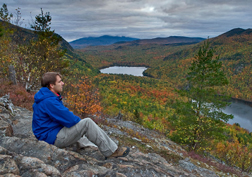Research Highlights: Ice Sheets and Climate Change
By Sean Birkel, Ph.D. Candidate in Earth Sciences, Climate Change Institute, University of Maine
Ice sheets are important components of the climate system, affecting global wind patterns, surface temperatures, and freshwater inputs to the world oceans. Two ice sheets still exist on Earth: the Greenland Ice Sheet in the Northern Hemisphere, and the Antarctic Ice Sheet in the Southern Hemisphere.

At times in the past when Earth’s average surface temperature was lower than it is today, the existing ice sheets were larger, and several other ice sheets covered much of the northern continents (Figure 1).
The height of the last major glaciation occurred 20,000-24,000 years ago, after nearly 100,000 years of gradual ice buildup. For poorly understood reasons, when the Earth was most firmly in the grips of an ice age, the great ice sheets began to recede, and within 15,000 years all but two had melted away entirely. Studying the natural cycles of these past ice ages can improve scientists’ predictions of future climate.
Ice ages are caused in part by variations in Earth’s orbital geometry and subsequent changes in the distribution and intensity of solar radiation. Joseph Adhemar, a 19th- century French mathematician, was the first person known to suggest an ice age-astronomical linkage. The astronomical theory was also pioneered by James Croll, and most famously by Milutin Milankovitch in the early 1900s. However, it was not until the 1970s that scientists confirmed from climate records that ice ages are paced by the precession of the equinoxes and changes in Earth’s axial tilt and orbit shape. Our current understanding is that thermal anomalies at the Earth’s surface over astronomical timescales result from complex feedbacks in the climate system and that orbital variations alone cannot account for the massive expansion of continental glaciers during ice ages.

Two enduring puzzles are 1) through what mechanisms do the great ice sheets form, and 2) how do they disappear? In my research, I am examining these problems using ice sheet and climate models in conjunction with existing geomorphic information (Figure 2). The ice sheet model I use was developed by Dr. James Fastook, a UMaine faculty member. I developed my own simple climate model in order to provide the ice sheet model with snow accumulation and ablation input values.
From my experimentation, I have arrived at noteworthy conclusions. First, the Laurentide Ice Sheet collapsed because of a mechanical instability that resulted from its contact with the ocean; in the absence of this instability, a significant portion of the ice sheet could have persisted under modern climate over Baffin Island and Foxe Basin. The marine instability mechanism is well known, and it was first postulated by glaciologists in the early 1970s. The novel finding is that, if a marine instability had not gutted out the interior of the ice sheet, the Laurentide could have persisted in contracted form by a surface height-mass balance feedback. The latter is the dominant feedback that sustains the modern Greenland Ice Sheet.
 A second experimental conclusion is that a persistent ice dome over Baffin Island and Foxe Basin could expand over eastern Canada in response to a 3°C cooling from modern baseline if sustained for as few as 10,000 years. The implication is that modest cooling arising from orbital changes could result in an explosive growth of the Laurentide Ice Sheet, which in turn would affect the rest of the global climate system through albedo, wind, and freshwater flux feedbacks. I suspect that the Laurentide Ice Sheet is a first-order amplifier of solar radiation anomalies that drives a major part of the ice age signal.
A second experimental conclusion is that a persistent ice dome over Baffin Island and Foxe Basin could expand over eastern Canada in response to a 3°C cooling from modern baseline if sustained for as few as 10,000 years. The implication is that modest cooling arising from orbital changes could result in an explosive growth of the Laurentide Ice Sheet, which in turn would affect the rest of the global climate system through albedo, wind, and freshwater flux feedbacks. I suspect that the Laurentide Ice Sheet is a first-order amplifier of solar radiation anomalies that drives a major part of the ice age signal.
My research focuses on a prevalent natural climate cycle. But we are coming to grips with the knowledge that human industrial activity is changing the composition of the Earth’s atmosphere. The best ocean-atmosphere models available indicate that greenhouse gas emissions are changing the climate, with the net effect being warmer surface temperatures and reduced snow and ice cover. Thus, it is not likely we will see an explosion of ice over Canada. However, two ice sheets remain today, and those ice sheets are a part of the climate system. How they behave will impact temperature and wind patterns, ocean currents, and global sea level. My research indicates that minor changes could result in drastic, perhaps unexpected results.
